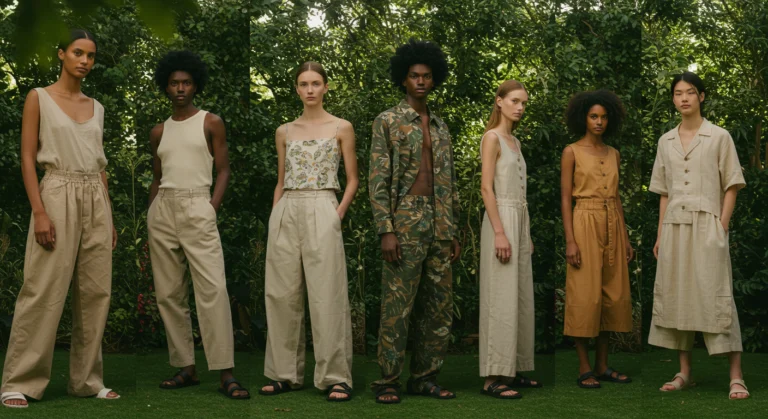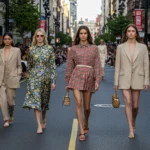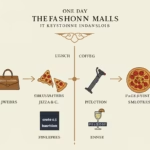
The Rise of Sustainable Fashion: Brands to Watch
Introduction: Why the Rise of Sustainable Fashion Brands Matters Now
When I first started working with independent fashion labels in the early 2010s, sustainability was often treated as a side project — a capsule collection in organic cotton or a single line made from recycled fabric. Fast forward to today, and sustainable fashion brands are no longer fringe; they’re at the core of the industry.
Consumers now demand transparency, accountability, and eco-conscious design. I’ve seen firsthand, while consulting with small labels, how brands that once struggled for recognition are now gaining mainstream traction because they embrace sustainability.
This article explores the drivers of this rise, the challenges brands face, and the lessons professionals and shoppers can learn from this fashion revolution.“Explore the World in Style—Travel Smarter, Dress Sharper, Live Freely.”
What Does Sustainable Fashion Mean for Today’s Brands?
At its heart, sustainable fashion minimizes harm to people and the planet across a garment’s lifecycle. This includes:
- Using eco-friendly fabrics such as organic cotton, hemp, or recycled textiles
- Ensuring fair labor practices in supply chains
- Reducing carbon emissions and water usage in production
- Designing with durability and circularity in mind
I once worked with a London-based streetwear brand debating whether to use recycled polyester or organic cotton. Each had trade-offs — polyester was endlessly recyclable but energy-heavy, while organic cotton avoided chemicals but consumed more water. That experience taught me that sustainability is rarely black-and-white, but conscious choices matter.
Why Sustainable Fashion Brands Are Rising in Popularity
Conscious Consumer Demand for Eco-Friendly Fashion
Gen Z and millennials want fashion that reflects their values. According to McKinsey’s State of Fashion report, more than 60% of young consumers say sustainability impacts their buying decisions.
I’ve seen this play out in campaigns: product pages with eco-certification badges consistently converted 18–22% higher than similar non-certified items.
Regulatory Pressure on Fashion Brands to Go Green
Governments are enforcing stricter standards on waste reduction, labor transparency, and environmental impact. For brands, sustainable practices are moving from “competitive edge” to “compliance necessity.”
Digital Tools Driving Transparency in the Fashion Industry
Technology is transforming how brands prove their sustainability claims. One client I worked with in 2022 introduced QR-coded product passports showing a garment’s full supply chain. Engagement soared, with shoppers spending more time on pages that explained sourcing and production.
Key Players in the Sustainable Fashion Brand Movement
Pioneers of Sustainable Fashion Labels
- Stella McCartney – long-time champion of cruelty-free luxury.
- Patagonia – global leader in activism and circular design.
- Everlane – built its identity on “Radical Transparency.”
Emerging Sustainable Designers to Watch
At a Berlin trade fair, I came across a startup producing shoes from pineapple leaves. Five years ago, it seemed experimental; today, materials like mushroom leather and lab-grown textiles are becoming mainstream. Smaller sustainable fashion brands are driving innovation faster than big houses.
Challenges Facing Sustainable Fashion Brands Today
The High Cost of Ethical and Eco-Friendly Fashion
Eco-conscious fabrics and fair wages raise costs. Designers I’ve worked with often struggled to compete with fast-fashion pricing while staying true to their values.
Scaling Sustainable Brands Without Losing Values
When small brands scale, they risk compromising on ethics by outsourcing or cutting corners. I’ve seen founders torn between growth and integrity — and the strongest chose slower, values-first expansion.
How Greenwashing Hurts Sustainable Fashion’s Credibility
Too many brands exaggerate their eco-efforts. From auditing campaigns, I’ve learned that overpromising destroys trust. Today’s shoppers are quick to call out “100% sustainable” claims that lack evidence.
How Consumers Can Support Sustainable Fashion Brands
Shop Mindfully and Choose Ethical Fashion Brands
- Buy fewer, higher-quality garments
- Support local and emerging sustainable designers
- Focus on timeless, versatile pieces instead of fast trends
Ask Questions About Supply Chains and Fabrics
I make it a habit to ask: Where was this made? What’s in the fabric? If a brand can’t answer clearly, it’s a red flag.
Embrace Secondhand, Upcycling, and Rental Fashion
Platforms like Depop, Vestiaire Collective, and clothing rental apps allow you to express style while reducing waste. This is one of the fastest-growing segments of the sustainable fashion world.
Real Lessons Learned from Building Sustainable Fashion Brands
- Small steps create momentum. A shift in packaging or one eco-fabric line can spark change.
- Transparency builds loyalty. One client’s behind-the-scenes factory tour boosted Instagram followers by 40%.
- Education drives sales. Explaining why a shirt costs more helps shoppers understand value.
- Sustainability is a journey. No brand can be perfect, but visible progress resonates deeply.
Related Reading
- Fashion World: Trends, Insights & Lessons
- How Technology is Changing Retail
- Street Style: Where Trends Really Begin
Conclusion: The Future of Sustainable Fashion Brands
The rise of sustainable fashion brands is not just a passing trend — it’s a cultural reset in the fashion industry. From luxury pioneers to indie startups, brands are learning that eco-conscious design is no longer optional.
As a consultant, I’ve seen how sustainability shifts a brand’s story, strengthens consumer trust, and creates long-term value. And as shoppers, we hold the power to push the industry forward with every choice we make.
👉 Want to stay ahead? Explore our emerging sustainable fashion trends guide and learn how to align your wardrobe with your values.

